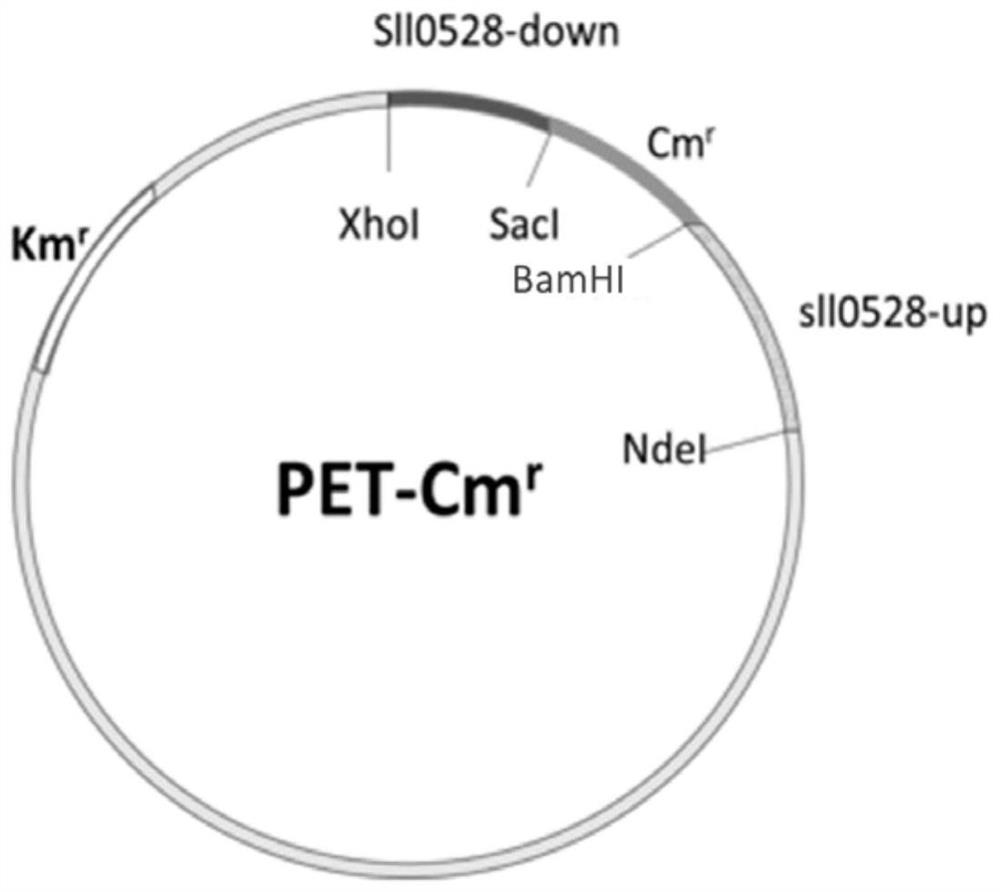Application of sll0528 Gene in Improving Ethanol Tolerance of Synechocystis pcc6803
A technology of PCC6803 and Synechocystis, which is applied in the direction of microorganism-based methods, the use of vectors to introduce foreign genetic materials, biofuels, etc., can solve the problems of poor tolerance to ethanol and the production of bioethanol that cannot meet the requirements of industrial production. The effect of broad application prospects
- Summary
- Abstract
- Description
- Claims
- Application Information
AI Technical Summary
Problems solved by technology
Method used
Image
Examples
Embodiment 1
[0039] Homologous recombination double crossover plasmid PET-Cm r and a build of P3031:
[0040] (1) Amplification of the insert:
[0041]Using the wild-type Synechocystis PCC6803 genome as a template, using SEQ ID NO: 1 and SEQ ID NO: 2 in the sequence table as the upstream and downstream primers of the gene sll0528 to be knocked out, SEQ ID NO: 3 and SEQ ID NO: 4 The upstream and downstream primers for the downstream of the gene sll0528 to be knocked out were amplified by PCR to obtain the upstream fragment sll0528-up and the downstream fragment sll0528-down of the gene sll0528 to be knocked out. Using the plasmid pACYC184 as a template and using SEQ ID NO: 5 and SEQ ID NO: 6 as upstream and downstream primers, the fragment Cm containing the chloramphenicol resistance gene was amplified by PCR r ; With wild-type Synechocystis PCC6803 genome as a template, with SEQ ID NO: 7 and SEQ ID NO: 8 in the sequence listing as the upstream and downstream primers of the target fragmen...
Embodiment 2
[0047] Obtaining of sll0528 gene knockout strain Δsll0528 and sll0528 gene overexpression strain Osll0528
[0048] (1) Plasmid transformation
[0049] Homologous recombination double exchange plasmid PET-Cm r After filtering and sterilizing with a 0.22 μm microporous membrane, put it into a 2 mL sterile centrifuge tube. A certain amount of BG11 medium (with HEPES buffer added) was added thereto, so that the final concentration of the plasmid was about 10 ng / μL. Take 30 mL of wild-type PCC6803 in logarithmic phase, centrifuge at 6000 rpm for 7 min, and remove the supernatant. Resuspend the algae mud with 20mL of fresh BG11 medium, centrifuge at 6000rpm for 7min, and remove the supernatant. Resuspend the algae mud with plasmid-containing medium. The resuspended algae liquid was cultured at 29°C, 150rpm, and 1400Lux continuous light for 6h. Apply the algae liquid to the solid medium covered with mixed fiber filter membrane and culture it under light for 1 day (upright cultur...
Embodiment 3
[0057] Phenotype analysis of Synechocystis sp. PCC6803 wild type, gene knockout strain Δsll0528, and gene overexpression strain Osll0528 under ethanol stress:
[0058] The wild type grown to the logarithmic phase, Δsll0528, Osll0528 was used as seed solution, and was inoculated to contain 0% (v / v), 1.5% (v / v), 2.0% (v / v), 2.5% (v / v) respectively. v), the starting OD of each bottle of algae in 50mL BG11 medium of 3.0% (v / v) ethanol 730 = 0.1. Continuous culture for 4 days, sampling OD every day 730 value to draw a growth curve. The culture conditions are 30° C., 150 rpm, 1800 Lux continuous light, and the experimental group and the control group have three parallels.
[0059] Figure 3-6 It is the growth curve of Synechocystis PCC6803 wild-type WT, Δsll0528 and Osll0528 strains under 1.5%, 2.0%, 2.5%, 3.0% (v / v) ethanol stress, and E in the figure represents ethanol. It can be seen from the figure that the growth state of Osll0528 was significantly better than that of the ...
PUM
 Login to View More
Login to View More Abstract
Description
Claims
Application Information
 Login to View More
Login to View More - R&D
- Intellectual Property
- Life Sciences
- Materials
- Tech Scout
- Unparalleled Data Quality
- Higher Quality Content
- 60% Fewer Hallucinations
Browse by: Latest US Patents, China's latest patents, Technical Efficacy Thesaurus, Application Domain, Technology Topic, Popular Technical Reports.
© 2025 PatSnap. All rights reserved.Legal|Privacy policy|Modern Slavery Act Transparency Statement|Sitemap|About US| Contact US: help@patsnap.com



